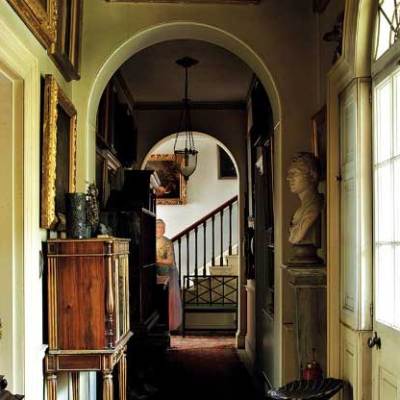Untitled (1990), Christopher Wool © Christopher Wool. Museum Boijmans Van Beuningen, Rotterdam. Photo Studio Tromp, Rotterdam

‘The Show Is Over’. This statement, drawn from Vasily Rozanov’s The Apocalypse of our Time (1917–18) and broadcast by Christopher Wool in paintings, drawings and billboards, can be interpreted as the defining narrative of nihilism. In 1993, copies of Wool’s Untitled (1990) were printed on ‘endless paper’ by Wool and Felix Gonzalez Torres, stacked up and offered to visitors. As long as there’s a space to deny, we’ll fill it by producing ever more elaborate denials. Wool’s painting, and the posters, can be seen at Gagosian’s current exhibition, which explores how abstraction in art has persistently denied and reasserted the act of painting.
The first symptoms of the death of painting were glimpsed in Malevich’s Black Square (1915). Its demise was later diagnosed by Mondrian and Rodchenko, and painting was still in the process of bidding farewell when Douglas Crimp published his essay on the subject in 1981. Since then, painting has merrily carried on ending – the only problem is it hasn’t stopped yet. Gagosian’s exhibition bases itself upon this ‘performative contradiction’, gleefully expounding on all sorts of ingenious paradoxes and neat negations in a catalogue essay by Malcolm Bull. It’s sold as an exhibition thick with theory – but for all the discussion of nihilism, it’s far from austere.
Curator Mark Francis also devised Gagosian’s 2010 exhibition, ‘Crash: Homage to JG Ballard’. Just as a Ballardian ‘crash’ is both a stark ending and a hyper-exaggerated event, ‘The Show is Over’ discusses its own demise with a series of exuberant, almost theatrical flourishes. The curation does not shy away from the question of beauty. A work like Rudolf Stingel’s Untitled (Ernst Ludwig Kirchner) (2013) sees abstraction openly embracing decoration in an expanse of regal purple and vestiges of peeling brocade.
Gallery 1 offers a symphony of works in melting gradations of monochrome, spiked with two orange bursts of synthetic fieriness – Mike Kelley’s Carpet #5 (2003) and Wade Guyton’s inkjet-printed Untitled (2011). The effect is like a match on an oil spill. In the middle of it all is Robert Rauschenberg’s White Painting (1951), one of the earliest pieces in the show and perhaps the one which, in its simple paradox of filled-in blankness, epitomises the cyclical quest for the end of painting.
The tone changes in Gallery 2. Here we witness painting’s elaborate deferrals of its scheduled death-scene, extending like a multi-volume suicide note. To quote Slavoj Žižek (Less Than Nothing, 2012), it is a ‘negation which is hindered, derailed, distorted, twisted, sidetracked’; the result is little short of baroque. This manifests itself primarily through experiments with materials – dirt, sugar, diamond dust, tarred feathers and cotton wool – but is also present at the level of curation, with all sorts of witty juxtapositions. Lichtenstein’s Mirror #1 (Four Panels) (1971) is neighboured by Richter’s Mirror (2008), which in turn reflects and becomes a version of Jeff Elrod’s adjacent Echo Painting (B/W) (2013).
With their titles coolly banished to a gallery guide, these works are allowed to speak through their own visual connections. The hang is unusually packed, almost verging on a type of horror vacui – the eccentrically shaped Gallery 2 is comparable to a pierside funhouse. On one side, Blair Thurman’s Undertow (2013) appears like the toothy maw of a performing lion, or a burst drum from which a glamorous assistant has just leapt; at the other end of the gallery, Steven Parrino’s Skeletal Implosion (2001) swirls like the awning of a big top. Paintings evoking ghosts, reflections and nebulous echoes meet their match in works that glue us back down to earth with gum, tape and tarmac, but not without offering an attractive tangibility.
The show might be over but, as Rozanov’s statement suggests, there are no coats to collect, no home to go to – so we might as well stay.
‘The Show is Over’ is at Gagosian Gallery, Britannia Street, London, until 30 November 2013.




